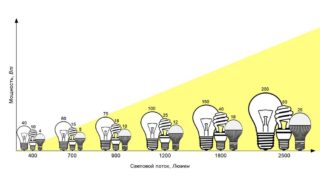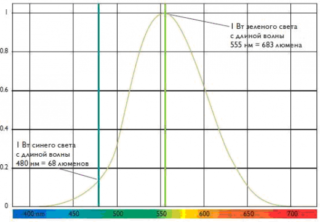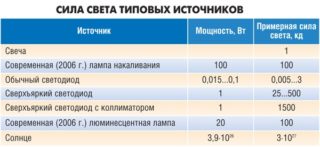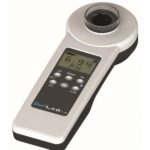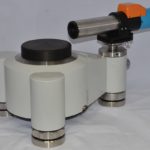The concept of luminous flux is used to determine the amount of light per square meter of area. The value is measured in lumens and allows you to specify how much light a single lamp or lighting system gives out.
What is luminous flux
By a stream of light is meant the power of radiation that a person or light energy coming from the surface (glow or reflection of a beam) can see. The full flux without taking into account the concentrated efficiency of the devices, but taking into account useless light, is measured in lumen-seconds.
The luminous quantity is not an analogue of the energy characterizing light without visual sensations. Light or radiant energy can be measured in joules. The unit of measurement of luminous flux is lumen, which means the glow from one source with a force of 1 candela. The solid angle in this case is 1 steradian.
The number of lumens of radiation depends on the brightness of the source.
How light is related to luminous flux
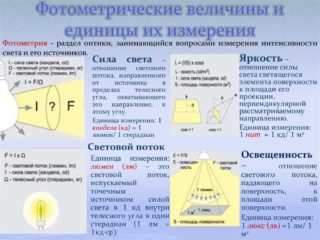 Illumination and luminous flux are different, although similar concepts. Light is measured in suites, not lumens. 1 lux means hit 1 lumen per 1 m2 of land.
Illumination and luminous flux are different, although similar concepts. Light is measured in suites, not lumens. 1 lux means hit 1 lumen per 1 m2 of land.
For clarity, you can compare the force and pressure. Using a small needle and applying a minimum of force, a high specific pressure coefficient is created for a particular point. Similarly, a luminous low flux can illuminate a separate area.
The interaction of the light flux and the illumination is easily understood by the example of a table lamp with a light flux of 1000 Lm. To ensure that the lighting is complete, they are guided by the norms of SNiP 52.13330. For the workplace, the value of 350 Lux is used, for the manipulation of small parts - 500 Lux. Illumination is also affected by the distance of the light source, the coloring of foreign objects, the presence of a mirror or window. That is, the table next to the white wall will receive more suites than the table standing at the dark.
To measure the illumination, use the light meter or the meter application on the smartphone.
Difference of illumination from a luminous flux
Illumination is the surface density when a light stream enters a site. In a horizontal plane, the surface is illuminated horizontally. To indicate the value, the letter E is used. You can calculate the illumination parameters (Lux) by the formula E = Ф / S, where:
- F - light flow in Lumens;
- S is the surface area in mm2.
The difference between physical quantities - 1 lux equals 1 lumen per m2 of lighting area.
To determine the illumination, it will be necessary to correlate the luminous intensity with the distance to a particular site. When light falls at right angles to the surface, the luminous flux area is smaller. With increasing angle, the percentage of illumination decreases.
Less light will fall on an object located away from radiation sources.
Norms of lighting premises for use (SNiP)
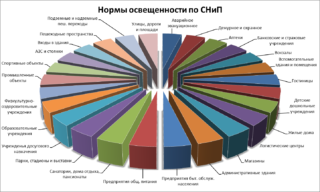 The norm of illumination is necessarily taken into account when arranging administrative, educational, leisure institutions, household enterprises, retail facilities, residential buildings, house adjoining territories, hotels, enterprises, as well as pedestrian-car zones in cities and villages.
The norm of illumination is necessarily taken into account when arranging administrative, educational, leisure institutions, household enterprises, retail facilities, residential buildings, house adjoining territories, hotels, enterprises, as well as pedestrian-car zones in cities and villages.
When selecting a lighting system, they are guided by the documents SNiP 23-05-95 from 1995 and its updated version of SP 52.13330 from 2011 for natural and artificial light sources.
Office lighting
Stress resistance, concentration of attention, mental activity of staff will depend on the level of lighting. You can familiarize yourself with regulatory requirements in the table.
| Type of premises | Illumination, lx |
| Large office with computer equipment | 200-300 |
| Large office with a free layout | 400 |
| Office for working with drawings | 500 |
| Conference hall | 200 |
| Stairs | 50-100 |
| Halls, corridors | 50-75 |
| Archival premises | 75 |
| Utility room | 50 |
Light intensity at work
To determine the indicator, the visual load is taken into account.
| Visual work discharge | Eye strain | Combined lighting | General lighting |
| 1 | Highest accuracy | 1500-5000 | 400-1250 |
| 2 | Very high precision | 1000-4000 | 300-750 |
| 3 | High precision | 400-2000 | 200-500 |
| 4 | Average accuracy | 400-700 | 200-300 |
| 5 | Minimum accuracy | 400 | 200-300 |
| 6 | Coarse | 200 | |
| 7 | Production control (surveillance systems) | 400 | 200-300 |
Warehouse Lighting
The intensity of the light sources depends on the type of storage and the type of lamp.
| Storage | Lamps | |
| Gas discharge | Incandescent | |
| On the floor | 75 | 50 |
| On shelves | 200 | 100 |
Lighting parameters in residential buildings and leisure centers
For the cabinet, billiard room, library, the standard table height is 0.8 m from the floor line.
| Type of premises | Lighting, lx |
| Elevator shafts | 5 |
| Movements on floors, attics, corridors | 20 |
| Premises for communication equipment | 20 |
| Pram and bicycle rooms | 30 |
| Stairs | 20 |
| Concierge Items | 150 |
| Bathrooms, showers, bathtubs | 50 |
| Billiard room | 300 |
| GYM's | 150 |
| Locker rooms, pools, saunas | 100 |
| Wardrobe rooms | 75 |
| Utility room | 300 |
| Corridors and halls in apartments | 50 |
| Libraries, cabinets | 300 |
| Children's room | 200 |
| Kitchen | 150 |
| Living spaces | 150 |
| Lobby | 30 |
These standards are taken into account when arranging wiring and installing lighting fixtures.
Luminous flux calculation
To calculate the luminous flux, you can use a special measuring device or focus on the light output depending on the flux:
- LED bulb in an opaque bulb - the power of the device, multiplied by 80 lm / W, will be the amount of luminous flux;
- filament sources - lamp power is multiplied by 100 lm / W;
- energy-saving CFL devices - multiplied by 60 lm / W;
- DRL - power is required to be multiplied by 58 lm / W.
The effectiveness of the method depends on the intensity of the light flux in the lamp, lighting standards, safety factors (object purity and type of source), the use of light flux, correction light, the number of lamps, and the area of the room. In the calculations, they also focus on the design of the device, the presence of a protective coating.
The error of theoretical calculations is about 30%.
The power of light
By light intensity is understood the value of the light flux divided by the solid angle within which it is located. If the light beam is set as volume, the force will be the spatial density. The indicator is measured in candela (Cd).
Candela is a unit of measure for the intensity of light that a pulsating wax candle has. It is equal to 1/683 W at a frequency of 540 to 1012 Hz, which corresponds to a green tint. 1 candela coincides with 1 lumen only if the light beam propagates at a conical angle of 65 degrees. Millikandels are used to indicate a directional device - indicator LEDs, small flashlights.
Watts and lumens
Until recently, when choosing bulbs, they focused on power, or the number of watts. The larger it is, the better the lighting. Now the designation of the quality of lighting is made in lumens.
But Watt cannot simply be converted to Lumen, since the first designation is power, and the second is the volume of light rays from sources. For transformation, it is necessary to know the light output (lm / W), as well as the type of lamp, reflector efficiency, losses in the presence of a diffuser, percentage of light flux leakage.
Instead of lengthy calculations, you should focus on the pivot table.
| Power, W | Luminous flux, Lm |
| Incandescent lamps | |
| 20 | 250 |
| 40 | 400 |
| 60 | 700 |
| 75 | 900 |
| 100 | 1200 |
| 150 | 1800 |
| Fluorescent lights | |
| 5-7 | 250 |
| 10-12 | 400 |
| 15-16 | 700 |
| 18-20 | 900 |
| 25-30 | 1200 |
| 40-50 | 1800 |
| LED sources | |
| 3-4 | 250-300 |
| 4-6 | 300-450 |
| 6-8 | 450-600 |
| 8-10 | 600-900 |
| 10-12 | 900-1100 |
| 12-14 | 1100-1250 |
| 14-16 | 1250-1400 |
If you want to save money, replace the 1000 W incandescent bulb with a fluorescent (25-30 W) or LED (12-15 W) device.
How and in what is the light flux measured
Light value - SP is measured in lumens. One lumen is similar to the SP of an isotropic light source with a force of 1 candela and an angle of 1 steradian.
In production, special instruments are used for measurements. This method allows you to accurately determine the joint venture:
- A photometer is a device with a camera sphere. The reflection coefficient of the inner part is 1. The measurement is carried out according to the principle of placing the bulb in the center of the camera and establishing a diffused light beam.
- Goniometer is a photometric device with a built-in light meter that can move around the sphere. In the process of integrating illumination, the value in lumens is displayed.
- Photometer
- Goniometer
The light meter is calibrated in absolute terms: 1 lm / m2 equals 1 lux.
An ordinary person, choosing a lamp or a lamp, does not have to go deeper into an accurate measurement system. When replacing an incandescent device with a halogen one, it is worth remembering that watts are not lumens. The former are used to determine power, the latter from illumination, and during operation, a standard lamp loses 15% brightness, a fluorescent lamp - 30%, LED - from 5 to 10%.
